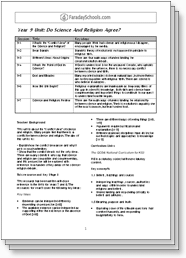RE Teachers’ Guides
Welcome to the NeverOffTopic website!
 This website has been designed to support teachers who work with students in Years 6-13 who are looking for ways to help students to consider a range of relationships between science and religion.
This website has been designed to support teachers who work with students in Years 6-13 who are looking for ways to help students to consider a range of relationships between science and religion.
The menu on the right takes you to the pupils’ pages.
On this page, we have put the teachers’ notes for the various units.
A note about the order of things
Many students struggle to understand the nature of science and the nature of religion, never mind the relationships between them. We suggest the following path as a way to build up some key ideas in pupils’ RS lessons:
In Year 7, the theme we suggest is the Theory of the Big Bang and Creation. The lesson objectives are to help pupils explore the idea that science and religion are addressing different types of questions. This is an essential idea in order to understand why some people see science and religion as compatible.
In Year 8 we suggest putting the focus on evidence. The RS unit on this website tells the story of Galileo, a scientist who advocated the value of gathering evidence to test and support scientific ideas. Galileo was among a number of scientists who say that God has created a world that is open to scientific exploration. He saw science as the appropriate tool for finding out how the Universe works and he saw religion as the appropriate tool for discovering God’s plan for the Universe.
In Year 9 the RS unit introduces the so-called ‘Conflict Thesis’. It explains that in the popular press, the reaction to the publication of Darwin’s theory of evolution was described as a two horse race – science or religion. In reality, in Darwin’s time as now, opinions varied about how to make sense of the scientific and religious explanations of human origins.
Overall then, the key message in these resources for students is that science is not necessarily incompatible with faith.
The lessons provided for KS3 are designed to support the new RE Framework, focusing on the following learning objectives:
Key Stage 2 (Primary)
• Pupils discuss different perspectives on questions about the beginnings of life on Earth, so that they can describe different ways science and religions treat questions of origins
Key Stage 3 (Secondary school age 11-14)
• Students develop insight into and understanding of why some people argue that science and religion can be compatible and others argue that they cannot
• Students develop their skills in reasoning and constructing arguments by debating questions and dilemmas about the nature of human life and the moral responsibilities of being human.
• Students consider philosophical, ethical and religious questions about what it means to be human, for example questions posed in relation to the development of new medical technologies.
The lessons for KS4 support GCSE specifications on topics that bridge science and religion
Teacher Notes and Whiteboard PowerPoints
Year 7
This unit investigates the ways in which science and religion are often perceived to be in conflict. Pupils will be asked to consider the idea that it’s possible for two claims to be different but both true.
Yr 7 Whiteboard PowerPoint for a more in-depth science focus (the Big Bang Theory)
Year 8
This unit examines reasons to believe something is true.
The aim is to highlight that science and religion are in the main, addressing different questions. The scientific way of gathering evidence to support ideas cannot be applied to the types of questions that are seen as significant in religious thinking. Some ways that religious ideas are supported are given.
Yr 8 Whiteboard Presentation 1 (Optical Illusions and Galileo)
Yr 8 Whiteboard Presentation (Looking for Evidence)
Year 9
This unit is about the “Conflict View” of science and religion. Many people feel that there is a conflict between science and religion. The unit aims to explain why the conflict view gets so much attention and identify that it is not the only view. The unit includes a lesson about the impact of Darwin’s theory when it was published and explains how scientists who believe in God today accommodate this theory.
Yr 9 Whiteboard Presentation (The Origins of Life)
Year 10-11
These units were updated in December 2012. Unit One addresses three key concerns (perceived lack of evidence; presence of natural disasters; plurality of religions) that can lead students to assume that the science-religion debate is not worth having. Unit Two moves on from these basic objections to seek to develop a proper understanding of what each discipline is and how each works. Unit Three examines evolution as an area of conflict and misunderstanding between science and religion. Unit Four explores questions about God including the question of whether we can still consider ourselves uniquely made in the image of God when genetics tells us we share a very significant proportion of our DNA with other organisms. Unit Five reflects on the question of animals’ relative importance when compared to humans, and on what ethical guidelines ought to shape our treatment of animals as a society.
Year-10-11-Unit-1-Asking-Questions
Unit Two – Reasons in Science and Religion
Unit Three – Evolution and/or Creation
Unit Five – The Value of Animals
Yr 10-11 Extension Sheet – Science and the Bible – Are they incompatible?